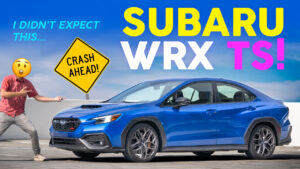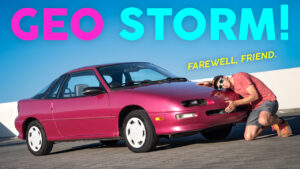
I Didn’t Expect The Subaru WRX tS Review To Go Like This…
I’ve got the key to the new Subaru WRX tS, the top-spec WRX you can buy—and I’m driving this “almost STI” for
It’s that time again. Let’s talk about four weird, uncommon, and forgotten cars from the 80s and 90s that I want to buy! In this video we look at the completely unremembered Renault Fuego, the obscure Canadian market Eagle Vista, the low-volume Kia Elan roadster, and the elegant but unsuccessful Buick Reatta. Can we find any of these to purchase, or are they all lost to history? Let’s find out!
The ’80s and ’90s were an interesting era for vehicles, and only somewhat recently have car enthusiasts started to realize that there are some fantastic cars from this time period.But today we’re not going to talk about the obvious ones like the Ferrari Testarossa, and the Lamborghini Countach. We’re going to talk about the weird, forgotten, and unloved cars from this era. Cars that just didn’t sell well, or were too weird for the buying public, or suffered from bad marketing, or maybe weren’t all that well built, or were considered disposable and got junked when repair bills got too high. Vehicles that you probably haven’t seen in ages.
Can we find any of these forgotten cars for sale, or will they all be lost to history? Open up your web browsers and let’s see what we can find!
Here’s one that I nearly forgot ever existed. When was the last time you saw a Renault Fuego? The Fuego is a front wheel drive sporty hatchback built by Renault and made available in the States by way of American Motors dealers, back when Renault had an ownership stake in AMC.

Based on the Renault 18i, the Fuego featured a very distinctive design, with its full length black body ridges. The Fuego was sold in the US from 1982 to 1986, and at the time of release it was the cheapest, most highly equipped turbocharged hatchback available here.
While several motors were used worldwide, in the US we could get Renault’s 1.6L turbo 4 cylinder making 107hp.Zero to 60 miles per hour could be achieved in about 10 seconds, not bad for the era. Renault facelifted the Fuego in ’84 and provided an optional 2.2L engine, but it provided only 3 more hp.

On paper, there is actually a lot in the Fuego’s favor.It was one of the best selling coupes in Europe between 1980-82. The Fuego was decently comfortable, had a very large, useful hatchback, got good gas mileage, came with a solid list of standard features, and could be had for a relatively low price. And, it was the first car available with keyless remote entry. Even Motorweek was singing its praises, saying “we think AMC/Renault has a sure winner”.
But here in the States, the Fuego hardly set the automotive industry on fire, selling just under 95k units from ’82 to ’86. Why were sales so poor? And where did those 95k Fuegos end up?

Even though Motorweek was congratulatory towards the Fuego, they did point some of its biggest shortcomings. It wasn’t a great handling car, and had less than stellar brakes. It was designed more for comfort than performance, which was at complete odds with Renault’s marketing campaign. Ads for the car featured F1 driver Alain Prost and linked the Fuego to Renault’s F1 heritage. But the reality was that the car was not quick, it wasn’t that sporty, and thus didn’t live up to the hype that Renault had created for it. Maybe with less optimistic marketing, it would’ve been better aligned with customer expectations.

But perhaps the biggest nail in the coffin of the Fuego, and perhaps Renault’s entire North American efforts, was the perception of poor reliability. I don’t have first hand experience with 80s Renault reliability, but there is plenty of anecdotal evidence that it wasn’t very good. There was even a recall where steering wheels would come off into drivers hands! Some have said that the Fuego was the “best looking car broken down on the side of the road.” Parts availability was tough as well. This reputation must have certainly affected sales.
Where are they all now? With resale values in the gutter just after its debut, most likely ended up in the hands of people who couldn’t afford upkeep or the patience to find parts.I have to imagine nearly all of them ended up in the jaws of the crusher.
Here’s one that as of yesterday I didn’t even know existed. Let’s talk about the Eagle Vista!

Now many of you might remember the Eagle brand name, used by Chrysler starting in 1988. In the States we got the super rad Eagle Talon, along with several other mostly forgotten cars like the Medallion, the Premier, and the Summit, before they killed off the brand in 1998.
The Eagle Vista hatchback and sedan are essentially rebadges of the 2nd generation Mitsubishi Mirage, and the Eagle Vista Wagon was a rebadge of the Mitsubishi Space Wagon. Eagle Vistas were only available in Canada.But if these cars look familiar, it’s because in the States, they were sold as the Dodge or Plymouth Colt. In Australia they were badged as Mitsubishi Colt. Many different names for the exact same cars.

The Eagle Vista sedans (along with the Dodge and Plymouth Colt variations) could be had with a 69hp 1.5L straight 4, or a zippy 102hp 1.6L turbocharged 4 cylinder. The wagons were available with a 2L inline 4.

I love the mini minivan functionality of the Vista Wagon. But if I had to choose one Vista, it would have to be the turbo hatchback. Though I haven’t even been able to find a photo of one!
Let’s take a look at the Dodge Colt Turbo, which is functionally and visually identical, apart from the badge.The Turbo hit 60 miles per hour in 9.8 seconds according to Motorweek, quick for the era. They praised its handling and braking, even though it did have a fair amount of torque steer. But that goes with the territory. I still want one.

Dodge and Plymouth Colts seemed to be a common sight in the 80s, but now most of them are gone. I have to imagine Eagle Vistas are even more rare today.
Next up is a convertible mash up! Designed by Lotus, developed with under the guidance of General Motors, and sold by Kia. It’s the Kia Elan!

Why such a convoluted path? To find out, we need to rewind back to 1989. Lotus, then a subsidiary of General Motors, released their first and only front wheel drive convertible sports car, the M100 Elan. Costing $55 million to develop, it was the most expensive project Lotus had ever taken on.

The choice to go with a front wheel drive layout was quite controversial at the time, as all Lotuses before and after the M100 Elan were rear wheel drive—as you might expect from a roadster. Why make the switch to front wheel drive? Lotus defended their decision saying a FWD layout would yield a faster car than a RWD design. However it’s possible the real reason might have been that GM didn’t have any 4 cylinder motors suitable for RWD applications.

But the concern of front wheel drive quickly faded once people got in and experienced the cars. At the time, it was one of the best handling front drive cars available. Autocar magazine even said it was the best front-wheel drive car they had ever seen.
It featured a fiberglass composite body, and the Turbo SE variant featured a 1.6L DOHC inline 4 cylinder from Isuzu making 162hp. 0-60 was very quick at about 6.5 seconds.

Sales of the Elan were well below expectations, especially in the US where only 559 of them were sold. Why did this critically acclaimed car sell so poorly? It comes down to price and timing. The Elan base price was nearly $34k ($67k in today’s dollars). And it was launched at just about the same time as the Mazda MX5 Miata. The Lotus was a futuristic and expensive take on the classic British roadster. But the Miata was a arguably a more pure representation, having more in common with the original 1960s Elan than the new Lotus did. And, the Miata was only $14 grand (about $27k in todays dollars). The Elan was clearly quicker and more powerful than the Miata, but many felt the Miata was much more fun to drive.
The M100 Elan is a great car, but its success clearly suffered from a high price and bad timing. The car was discontinued in the states in 1992. The car was a huge financial failure for Lotus, after investing $55 million into the project and selling so few of these cars.

So, let’s get back to Kia. How do they fit in to this picture? Lotus sold the rights to the vehicle to Kia—quite possibly as a way to recoup some of their investment. And Kia release it as the, Kia Elan. The main design difference between the Lotus and the Kia is the taillights. The Kia Elan also ditched the Isuzu engine in favor of a 151hp 1.8L Kia motor. From 1996 to 1999, a total of 1,056 Kia Elans were built.

So as you can see both the Lotus Elan and the Kia Elan did not sell very well. A Lotus isn’t exactly the type of car that gets junked when it gets old, so I have to imagine many Elans are still kicking around somewhere.
Buick made a luxury two seater in the late 80s and early 90s? They sure did, and it was called the Buick Reatta.

The Buick Reatta is a two seater “personal car” built by General Motors from 1988 to 1991, intended to be Buick’s halo car. The Reatta was based on a modified E body platform, sharing much in common with the Buick Riviera and Oldsmobile Toronado.
Even though the car has a somewhat sporty look, it was not positioned as a sports car. Marketing for the car focused on comfort and practicality over performance. It seems GM was trying to attract a younger demographic with the looks, but didn’t want to alienate traditional Buick buyers, who were, as you might have guessed, really old.

Under the hood is GM’s tried and true 3.8L V6. It made 165hp, and was bumped up to 170 for last year of production. The only transmission option was a 4 speed auto. 0-60 could be achieved in 9 seconds, not bad for the era. I wonder if GM would’ve allowed the Reatta to be quicker had they not worried about it competing with the Corvette and Pontiac Fiero.
The Reatta came with tons of standard features.It even had a 16 way power adjustable seat! Also a central feature of the interior was Buick’s “Graphic Control center” touchscreen, first seen on the Riviera.Yes, a CRT touchscreen in the late ’80s!This display controlled the stereo, HVAC system, trip computer, among other things. It was actually way ahead of its time, but unfortunately not always reliable. Reviewers panned it as unnecessarily complex and hard to use. GM ditched the control center on later Reattas in favor of a more traditional dash.

The design and manufacturing process of the Reatta was quite different than what GM would’ve done for a high volume car. Instead of a conventional assembly line, Buick used a system where cars were moved from station to station, requiring more hand labor and individual attention than usual for GM.
Ultimately, very few people decided to plunk their cash down on Buick’s new halo car. What caused such slow sales? It seemed as if Buick was trying to appeal to everyone which effectively meant they appealed to just about no one.

The Reatta wasn’t quite sporty enough to lure younger baby boomers. It wasn’t quite luxurious enough to convert Mercedes buyers. And being a small 2 seater didn’t align with the needs of the older, traditional Buick clientele.
The Reatta became an unintentionally rare vehicle—General Motors intended to sell 22k Reattas a year, but didn’t even sell that many during its entire four year run. Even introducing a convertible in 1990 had little affect—sales of the ragtop were barely noticeable. After 4 years of sluggish sales, GM decided to kill off the Reatta in ’91.

Overall, the Reatta was a pleasant and interesting car but didn’t ever really align with a particular buyer. And the Riviera on which it was based came with a back seat and was less expensive.
What if Reatta had come with a supercharged V6? Or a manual transmission? Would it have appealed to younger buyers? Or was Buick destined to remain the brand of choice for grandmas and grandpas everywhere?

Even though the Reatta didn’t sell all that well, it did attract some younger buyers to the Buick brand, and apparently was popular with women, who accounted for about half of all Reatta owners.
I’ll have more videos with my collection of ’80s and ’90s cars, reviews of new and used cars, and road trips to unique locations. And of course more videos where we look back at the rad cars of the past. Are there any cars you’d like to see me feature? Let me know!

I’ve got the key to the new Subaru WRX tS, the top-spec WRX you can buy—and I’m driving this “almost STI” for

I recently imported a 1997 Toyota Caldina GT-T—a turbocharged, 256 horsepower, all-wheel-drive station wagon! BWhen you import a vehicle from Japan, it

The time has come! I’m selling the cutest, most adorable car I own, my pink 1993 Geo Storm. Many people don’t even
One Response
We had a 1982 Fuego, and loved it. We had seen them for several years in Hong Kong and were on the waiting list. Got the second one to come into the country. Took a road trip in it from Boston to Seattle, the long way, all the way down the right side through Virginia, Georgia, Florida, across the bottom through Louisiana, Texas, New Mexico, etc., and then up the left side to Seattle. People at gas stations had no idea what it was. They would ask us if it was a Porsche. We owned that car for nine years and went through six alternators. It was next to the manifold, and the heat shielding was, shall we say, less than adequate. Only problem, really. The 23% interest rate under Jimmy Carter took its toll and may have contributed to low auto sales all around that year. And it was more of a leisure car than either a sports car or a workhorse. We replaced it with a 1991 Jeep Wrangler, which is both, in my view.